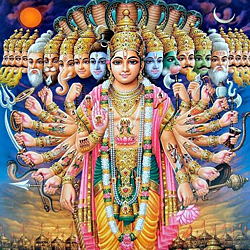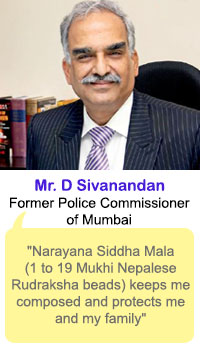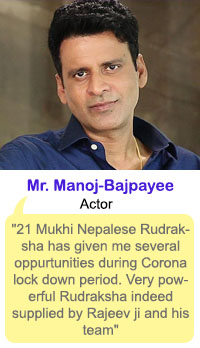
Some Salagramas resemble in shape a conch; some have linga-marks on them, some are shaped like tortoise, some like a boar, some like a fish. These are in fact identified as the forms of Vishnu, based on the characteristic marks which they have. Considered by the characteristics, the Matsya-salagrama gives long life and prosperity, the Kurma-salagrama provides progeny and wealth, Varaha-salagrama secures suzerainty, Vamana-salagrama burns up all sins, and Narasimha-salagrama wards off fears and anxieties.
There are some curious Salagramas- The Jvala-narasimha-salagrama shows flames, when held against the light. The Ratna-garbha-salagrama is translucent but assumes bright blue colour when seen in the sun. it is believed that one can recognize the forms of the ten incarnatory forms (dasavartar) in this stone, on the respective ‘jayanti’ days.
The Lajavarta-salagrama acquires an ochre colour when held to the sun. the Dakshina-murti-salagrama has the shape of a conch, but is black in colour. The Hiranya-garbha-salagrama is round at its rear portion and has two small dots which shine like gold. The Vasudeva-murti-salagrama in its chakra-dhara variety exudes water-drops constantly; it has a hollow portion for the opening (vadana), having a pair of chakras on top as well as the bottom, the two pairs being exact copies of each other.
The Matsya-murti salagrama will have a physical form that will recall the fish; the Hayagriva-murti-salagrama will be like a horse’s head; the Varaha-murti-salagrama will have a snout like protuberance; Narasimha-murti-salagrama will have a gaping mouth with sharp teeth-like structures. The Matsya-murti-salagrama is particularly recommended when it has a chakra on the tail portion (viz. Rear).
There are numerous popular beliefs concerning salagrama. Salagrama alongside Tulasi leaves and conch (samkha), placed in one plate is regarded as most meritorious.
Any religious observance, gift, consecration, obsequies, and worship should preferably be done in association with a salagrama: (Brahma-vaivarta-purana, Prakti-khanda, 19).
Regarding the obsequies or the last rites (sraddha), it is usual to conduct such ceremonies in front of a salagrama. For that would ensure the departed spirit reaching Vishnu’s abode directly: and subsequent death ceremonies would become unnecessary: (Padma-purana, uttara-khanda, 127).
When the dying person is made to sip a little of the water in which the salagrama-stone is bathed, he will be freed from all sins, and will reach the heavenly abode of Vishnu. And death itself when it occurs in the presence of a salagrama-stone will pave the way for Vishnu’s realm, for Vishnu is present in that stone. (Purana-samgraha)
The rites of expiation of sins (prayaschitta) becomes effective more by drinking the water in which these stones are washed than by gifts or fasting or by observances of various kinds.
In times of solar or lunar eclipse, whatever ritual is undertaken becomes all the more effective when done in front of a salagrama-stone so says Hemadri.
It was practice in the olden days to ask the witness to hold a salagrama in hand while testifying in a court of law; if he uttered utter falsehood, he was believed to suffer immensely and long as a punishment: (Brahma – vaivarta – purana, op. Cit.)
Merely looking at a salagrama stone would wash away the sins of the beholder, even as the mere sight of a lion would make the antelopes run for their lives in the forest.
Whoever glances at a salagrama would be purified of his past demerits; what then would be the benefit of one who is mindful of it, who praises it, meditates on it, worships it, and prostrates before it?
Whether one has real devotion or not, if he worships a salagrama-stone with prostration before it, he will surely get emancipated from the cycle of phenomenal existence. The person who offers a daily service for the salagrama stone will be freed from the fear of death, and he will cross over the stream of births and deaths. A regular worship of the salagrama-stone, bathing it in curds, ghee, milk or water will cause untold merit. In the salagrama-stone abide the three realms, and all the immovable and movable aspects of creation; and hence Vishnu resides in it.
The gifting of a salagrama-stone is also described as most meritorious. One who with delight in his mind worships a salagrama-stone placing it in front of him, will instantly obtain the merit of performing a million sacrifices. When excellent men worship a salagrama-stone, the area of a yojana (three miles) all around that spot, would become as holy as all the sacred places of pilgrimage together in one spot.
Even the worst criminal who has committed countless sins will instantaneously get purified by sipping water in which salagrama stone has been washed. Also Tulasi leaves, sandal paste, discus, Gomati-sila (stone from Dvaraka), conch, bell, salagrama (stone from the Gandaki), lamp (sikha, flame of light) a vessel of copper, uttering the name of Vishnu and sipping the water in which the salagrama has been bathed – these nine will burn down the mass of sins, so say the learned sages: The Devotee who worships the salagrama-stone must be of good conduct, free from arrogance and infatuation, and averse to temptations of sex and wealth; he must worship with influence and deliberation.
For worshipping sacred salagrama-stones, there is no need for a guru (the preceptor or master who initiates), a mantra (the hymnal formula given formally by the preceptor) japa (ceremonial repetition of the mantra), bhavana (visualization of a deity), stuti (eulogy) or an upachara (Service).
An even number of salagrama stones must be worshipped, but they must not be only two; an odd number of them is never worshipped, but one or four onwards even number only is regarded best.
If a person worships daily twelve salagrama-stones with devotion, his merits will increase, and sins will be destroyed: The salagrama stones must never be bought or sold; they must be presented by a teacher or well-wisher, or gifted by an ascetic freely. A commercial transaction in this regard is sinful for all those who are involved in it: (Padma-purana, Patala-khanda, 11)
It should be received with reverence in the cupped hands and placed on ones own head, as a mark of acceptance. Even as the fire lies latent in wood, and bursts out when ignited, Vishnu pervades the salagrama-stones and appears when the stone is worshipped.
A salagrama-stone continues to be worthy of worship even when it is broken. Split or cracked, it does not lose its auspicious nature. Only the mark of the discus must be present in the stone.
 Google has chosen Shaligram Shala ( shaligram.com) as the world's first 5 star
Google has chosen Shaligram Shala ( shaligram.com) as the world's first 5 star  rated Rudraksha supplying Company
rated Rudraksha supplying Company 

 Google has chosen Shaligram Shala ( shaligram.com) as the world's first 5 star
Google has chosen Shaligram Shala ( shaligram.com) as the world's first 5 star  rated Rudraksha supplying Company
rated Rudraksha supplying Company 

 Types of Shaligram
Types of Shaligram













































